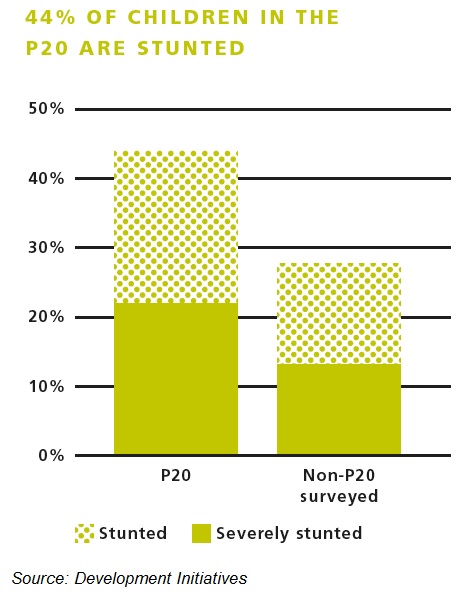Agenda 2030 and the Sustainable Development Goals have brought us a global commitment to end extreme poverty and ensure no one is left behind. For this ambition to be met, we need to know who the poorest people in the world are, understand their lives, and ensure they are included in progress. The P20 Initiative is a project focusing on the people who are in the poorest 20% globally. It aims to track their progress and improve information about their lives in order to ensure no one is left behind in efforts to tackle poverty. This briefing focuses in on nutrition.
Malnutrition underlies 45% of child deaths − approximately 3 million deaths per year. Basic nutrition underpins a child’s ability to grow and learn and an adult’s ability to work, take up opportunity and live a healthy and long life.
Without assured nutrition, it will be impossible to reach internationally agreed targets for basic health, education and economic prosperity.
Nutrition is a bellwether indicator for progress for the P20. It is both a result of other investments (health, education, employment, female empowerment, and poverty and inequality reduction) and a fundamental prerequisite for social and economic progress.
Malnutrition and poor diets constitute the number-one driver of the global burden of disease.
- Around the world, 23% of children are stunted by lack of access to basic nutrition − this has both physical and developmental implications.
- Amongst children under age 5 within the poorest 20% of the population, 44% are stunted.
The P20 carry a disproportionate burden of the impact of malnutrition through adulthood as well.
The data on adult malnutrition is weak. Out of the 99 household surveys used for this analysis, only 44 provide data on women’s BMI and only 13 include any metrics on BMI for adult men.
- 46% of women surveyed who were severely thin (with a BMI of <16) were amongst the poorest 20% of the population.
- A BMI of <16.0 is associated with a markedly increased risk for ill health, poor physical performance, lethargy and even death. [1]
Data on malnutrition is updated alongside regular household survey schedules. It will be monitored annually by the P20 Initiative as a bellwether for broader progress in support of Sustainable Development Indicators on ending all forms of malnutrition.
Read more about our P20 Initiative
Explore further P20 briefings on:
Civil Registration Systems and Vital Statistics
